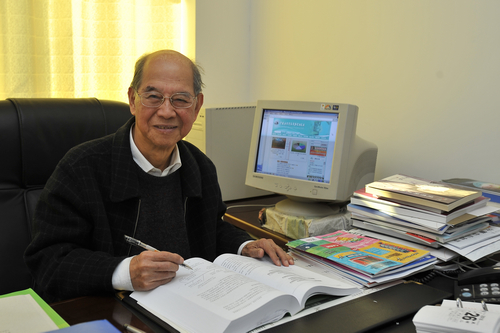XIE Jialin wins China’s top science award
Prof. XIE Jialin, an expert in accelerator physics and technology, free electron laser won China’s top science award on February
 |
| Prof. XIE Jialin |
XIE, Academician of the Chinese Academy of Sciences, was conferred the State Top Scientific and Technological Award and a bonus of five million yuan ($794,900) at a ceremony held in the Great Hall of the People in Beijing. The ceremony was attended by state leaders, including President Hu Jintao, Premier Wen Jiabao, as well as senior leaders Li Changchun and Li Keqiang. China has given the annual award to elite scientists and researchers for twelve consecutive years since 2000.
Prof. XIE was born in Harbin, Heilongjiang Province in August of 1920. He graduated from Department of Physics, Yanjing University and went to the United States for further study. At California Institute of Technology, XIE obtained M.S. degree at Department of Physics, and then he got Ph.D degree at Department of Physics, Stanford University.
From 1951 – 1955, he worked at the microwave and high energy physics laboratory, Stanford University. Then he became the responsible person for building an accelerator at Michael Reese, Chicago, which was a medical accelerator with the highest energy (45 MeV) at that time in the world.
Following the successful pre-fabrication research, upon return to China in 1955, of various components of an electron linear accelerator, such as electron gun, accelerating tube, high power pulse modulator, microwave system and high power klystron, he built the 30 MeV electron linac in 1964, which was the first one ever built in China. He was awarded Scientific and Technological Achievement Prize at the National Science and Technology Conference in 1978.
During the designing, R & D and construction of the BEPC from 1981 to 1986, he was appointed technical responsible person and BEPC project director. He made important decisions on the requirements of subsystems of the BEPC and by grasping the key link of scientific management; he followed the critical path method. He brought into full play the initiative of the Chinese science and technology community and industries by stressing self-reliance and hard struggle and strengthened international collaboration and exchange. The successful completion of the BEPC is a good example in carrying out the reform and open door policy and international collaboration of science and technology. Its luminosity is four times that of SLAC’s SPEAR. The precise measurement of tau mass was carried out at the BEPC with an important result achieved, which aroused world attention. In 1990, he was awarded a Supreme Prize for National Science and Technology Progress and also the “National Qiaojie Shijia Prize”.
On learning the establishment of free electron lasers in the world – the latest development in the field of science and technology, he proposed that the Beijing Free Electron Laser be developed, and then worked out the concrete scheme. With the fund provided in 1987 under the State 863 High Tech Program, he succeeded in building China’s first infrared free electron laser which produced spontaneous emission in May of 1993 and the lasing reached saturation at the end of 1993. Following those built in the U.S. and Western Europe, this was the first infrared free electron laser built in Asia. In 1994, he was awarded by CAS the Supreme Prize for Science and Technology Progress.
In the above-mentioned work, he made important contributions. In 1995, he was awarded Hu Gangfu Physics Prize by the Chinese Physical Society and also Ho Leung Ho Lee Foundation – Ho Leung Ho Lee Prize. Besides his research work, he has cultivated talents for the country, including 4 with Ph.D degree and 1 with M.S. degree. He published dozens of papers in some important domestic and foreign periodicals. The treatises he published include <Theory of Klystron Bunching>, <Preliminary Design of Beijing 2.2/2.8 GeV Electron Positron Collider>, <Beijing Electron Positron Collider and Beijing Spectrometer> and <Accelerator Story of Innovation of Science and Technology>. He also co-edited <Proceedings of the International Conference’97 on Free Electron Laser>. In 1998 he obtained the patent on A New Type of Electron Linear Accelerator.
He has published over 40 scientific dissertations and several specialized publications. As an associate professor in universities and institutes, XIE has nurtured a great number of accelerator-specialized experts. At present, Professor XIE is still active in the frontier of accelerator research and making his contributions to the sustainable development in high energy and accelerator research.